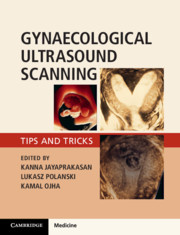Book contents
- Gynaecological Ultrasound Scanning
- Gynaecological Ultrasound Scanning
- Copyright page
- Contents
- Contributors
- Chapter 1 Get to Know Your Machine and Scanning Environment
- Chapter 2 Baseline Sonographic Assessment of the Female Pelvis
- Chapter 3 Difficult Gynaecological Ultrasound Examination
- Chapter 4 Sonographic Assessment of Uterine Fibroids and Adenomyosis
- Chapter 5 Sonographic Assessment of Congenital Uterine Anomalies
- Chapter 6 Sonographic Assessment of Endometrial Pathology
- Chapter 7 Sonographic Assessment of Polycystic Ovaries
- Chapter 8 Sonographic Assessment of Ovarian Cysts and Masses
- Chapter 9 Sonographic Assessment of Pelvic Endometriosis
- Chapter 10 Sonographic Assessment of Fallopian Tubes and Tubal Pathologies
- Chapter 11 Role of Ultrasound in Assisted Reproductive Treatment
- Chapter 12 Operative Ultrasound in Gynaecology
- Chapter 13 Sonographic Assessment of Complications Related to Assisted Reproductive Techniques
- Chapter 14 Sonographic Assessment of Early Pregnancy
- Chapter 15 Tips and Tricks when Using Ultrasound in a Contraception Clinic
- Chapter 16 Doppler Ultrasound in Gynaecology
- Index
- References
Chapter 15 - Tips and Tricks when Using Ultrasound in a Contraception Clinic
Published online by Cambridge University Press: 28 February 2020
- Gynaecological Ultrasound Scanning
- Gynaecological Ultrasound Scanning
- Copyright page
- Contents
- Contributors
- Chapter 1 Get to Know Your Machine and Scanning Environment
- Chapter 2 Baseline Sonographic Assessment of the Female Pelvis
- Chapter 3 Difficult Gynaecological Ultrasound Examination
- Chapter 4 Sonographic Assessment of Uterine Fibroids and Adenomyosis
- Chapter 5 Sonographic Assessment of Congenital Uterine Anomalies
- Chapter 6 Sonographic Assessment of Endometrial Pathology
- Chapter 7 Sonographic Assessment of Polycystic Ovaries
- Chapter 8 Sonographic Assessment of Ovarian Cysts and Masses
- Chapter 9 Sonographic Assessment of Pelvic Endometriosis
- Chapter 10 Sonographic Assessment of Fallopian Tubes and Tubal Pathologies
- Chapter 11 Role of Ultrasound in Assisted Reproductive Treatment
- Chapter 12 Operative Ultrasound in Gynaecology
- Chapter 13 Sonographic Assessment of Complications Related to Assisted Reproductive Techniques
- Chapter 14 Sonographic Assessment of Early Pregnancy
- Chapter 15 Tips and Tricks when Using Ultrasound in a Contraception Clinic
- Chapter 16 Doppler Ultrasound in Gynaecology
- Index
- References
Summary
Long-acting reversible contraceptives like intrauterine devices (IUDs) and systems (IUSs) and subdermal implants (SDIs) are widely used contraceptive devices in the world today. Intrauterine devices and systems together are referred to as intrauterine contraception (IUC). In the UK, IUCs and SDIs constitute approximately 38 per cent of the contraceptives used by women of reproductive age. Imaging plays an important role in a contraceptive clinic in ensuring IUDs/IUSs are correctly sited, locating them in case of missing threads and aiding in their removal or insertion. Of the imaging methods available, ultrasound is the most commonly used due to ease of availability, lack of exposure to radiation and cost-effectiveness. The transducers used to locate IUCs are usually a transvaginal probe and a curved transabdominal probe. The latter proves to be very useful in performing ultrasound-guided procedures.
- Type
- Chapter
- Information
- Gynaecological Ultrasound ScanningTips and Tricks, pp. 211 - 218Publisher: Cambridge University PressPrint publication year: 2020
References
- 1
- Cited by

